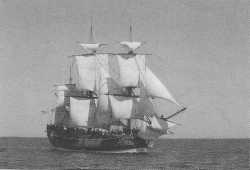- Author
- Ellis, John
- Subjects
- Ship histories and stories
- Tags
-
- RAN Ships
- None noted.
- Publication
- December 2006 edition of the Naval Historical Review (all rights reserved)
(with apologies to Kenneth Horne et al) – by John Ellis (Member)
The author was a volunteer member of the crew of HM Barque Endeavour on passage from Sydney to UK via Cape Horn in 2002. A film crew onboard recorded the bad weather rounding the Horn for use in the epic film Master and Commander, starring Russell Crowe. This is a record of his experiences, as recounted to members of the Historical Society on his return.
The voyage from Bluff (NZ) to Cape Horn took five and a half weeks and for four weeks, we made good progress, averaging 145 miles per day. Furthermore the winds were favourable, allowing a course in the general direction of Cape Horn. For the fortnight prior to 2 April 2002, we were sailing east between the 55th and 56th parallels South latitude.

(Photo: John Lancaster, courtesy HM Bark Endeavour Foundation Pty. Ltd.)
From 2 April, southerly winds gradually drove us north to the 51st parallel. These winds brought cold weather with snow, sleet and hail. (My camera also complained with the alarm telling me that the battery did not like the cold). The wind grew stronger and seas worsened. The topsails and main course were handed in winds of 45 – 50 knots gusting to over 60 and three hands were necessary on the wheel. On completion of gasketing ((gasketing – to shorten sail by securing the sail higher to the yard. Gaskets are short lengths of plaited cord to secure a furled sail to its yard (A Sea of Words by Dean King (2000) – a lexicon and companion to the complete seafaring tales of Patrick O’Brian)) the sails the Captain complimented us with: ‘You’ve all just qualified as extras in The Perfect Storm.’ Sea conditions led to several injuries, despite the Mate reminding all to have ‘one hand for oneself and one for the ship’. General maintenance and cleaning were limited to essential tasks.
Waves frequently broke across the waist, giving those in their hammocks (0.7m under the deckhead) the feeling of being in a waterfall as the torrent sloshed aboard. Less often waves broke across the quarterdeck, sending water down the after companionway, the only access to the upper deck. A few unfortunates timed their ascent of this ladder to coincide with an icy deluge. Could it get worse off Cape Horn?
Off Chile we did not make a landfall but we did see the loom ((loom – the glow of a light visible over the horizon before the actual source of the light can be seen above the curvature of the earth (sea).(Ibid)) of the Cape Evangelistas light at 50 miles. This island is a rocky outcrop off the western entrance to the Straits of Magellan. To continue would have placed us in the worst of situations, a sailing ship off a lee shore.
On 11 April the Captain put the ship about and we retraced some of our hard-gained miles to give more sea room and a safe course south west of Terra del Fuego. We never saw the islands that form the southern side of the Straits of Magellan; however, the name of the westernmost, Desolation Island, conjured up a place low on the list for one’s holiday destinations.
The storm abated and light winds backing to the southwest allowed us to maintain a good course for Cape Horn. One day, when we had covered only 51 miles, I felt we were hardly battling our way around Cape Horn. The mild conditions allowed Paul Atkins and John Anderson, from National Geographic, to go off in the ship’s Zodiac dinghy to take film footage of the ship. When they returned I was fortunate to go out and do the same. There were six of us in a 4m dinghy bobbing about in the Drake Passage. A local albatross settled on the water some 4-5m away and his quizzical look seemed to say, ‘You don’t seem to belong here.’
Then we had an emergency to attend to. Malcolm Evans’ pet, an (inflatable) emperor penguin (KP), who had been admiring Malcolm’s boat handling skills, overbalanced from the rough tree rail and fell overboard. Malcolm reacted smartly, putting on full throttle and KP was in the Zodiac within a few minutes and didn’t require further inflation.




